Surprisingly powerful, cheap to make, robust under combat conditions, and much simpler to operate than the finicky trebuchets, this ancient machine continued to be used right up the end of the middle ages, when it was finally replaced by cannons.
Onager (Torsion powered)
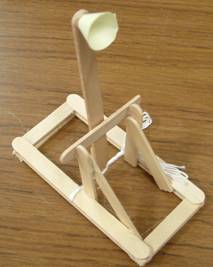
Pros:
- --Historically authentic
- --Looks cool
- --Powerful and accurate
- --Easy to operate and aim
- --Simple, small, portable
- --Mostly easy to build
Cons:
- --Difficult to modify once built
- --Hard to repair if the rope breaks
- --May lose some of its power over time (because the rope stretches)
- --The firing mechanism is difficult to build and may require extra help
Materials:
- 5 Full Sticks
- 5 Sticks cut or broken in half
- 3-4 feet of string
- 1 ½" square of paper
- Scissors
- Hot glue
How to Build It
• Make the base and the uprights
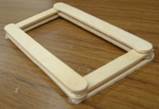 Glue together four full sticks and four half sticks, "log cabin" style. Put the half sticks on the bottom. Glue together four full sticks and four half sticks, "log cabin" style. Put the half sticks on the bottom.
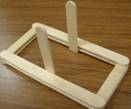 Attach two half sticks, flat side down, in the middle of the long side of the base, as shown below. These are the uprights. Attach two half sticks, flat side down, in the middle of the long side of the base, as shown below. These are the uprights.
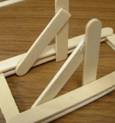 Brace the uprights with two half sticks, as shown below. Brace the uprights with two half sticks, as shown below.
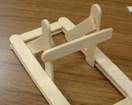 Attach a half stick across the uprights, on the opposite side from the braces. This is the crosspiece. Attach a half stick across the uprights, on the opposite side from the braces. This is the crosspiece.
??How would attaching the crosspiece higher or lower affect the performance of your catapult? You might attach it with masking tape, so you can try it in several places before you glue it.
Make the throwing arm
- Tear your piece of paper to the center. Fold it into a cone and glue together.
- Use scissors to trim the sharp corners of the cone.
- Smash the tip of the cone flat and glue it to the end of a full stick.
- Attach the rope.
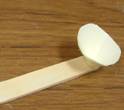
??How would different types of strings affect the performance of your catapult? You might try using wool yarn, artificial sinew (waxed cotton), jute or nylon twine, or other kinds of string. The ancient Romans used rope made of sinew or hemp, but both of these materials are very hard to find these days.
• Take your piece of string and fold it in half. Hold the folded tip in your lips (or get a friend to hold it for you) and twist the string together ten or twenty times.
• Fold the string double again, but let the string hang by one end. It should twist itself together part way. Again, hold the loose ends in your lips and twist it all the way.
• Repeat step B once more. You should now have a strong, thickly twisted rope.
• Thread the rope between the two full sticks under the cross piece, as shown below. Tie in place around the top stick with a square knot or double overhand knot. Move the knot to the side.
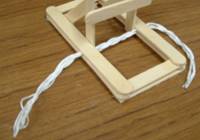 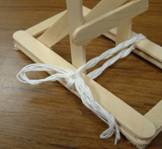
??What advantages and disadvantages might come with using thicker or thinner string? What changes would you have to make to your base if you were to use a thicker string?
Attach the arm
!!!You might need a friend to help with this step-it is difficult with only two hands. Either way, have your glue gun and throwing arm handy before you begin.
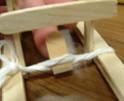 • Take your remaining half-stick and cut it in half again. This is your rope twister. Insert the flat end between the ropes. Twist backwards (away from the uprights) the desired number of times. • Take your remaining half-stick and cut it in half again. This is your rope twister. Insert the flat end between the ropes. Twist backwards (away from the uprights) the desired number of times.
??How many twists should you put on the rope? How will a tighter twist affect the performance of your catapult? Are there any risks to a very loose or very tight twist?
• After you have the rope twisted as tightly as you want it, put a generous gob of glue on the rope twister. Attach the throwing arm and hold in place for a minute or so to let the glue set.
• If you did it right, the arm should smack against the crosspiece when you let it go.
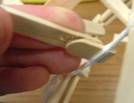 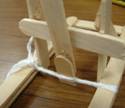
Firing
• Holding the base with one hand, pull the arm all the way down. Put the projectile in the cone. Release.
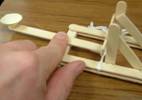
 1000 Woodsies Craft Sticks 1000 Woodsies Craft Sticks
- Natural raw wood
- Birch wood, non food safe
- Great for use in classroom projects, party crafts, and camp crafts
- Ideal for crafters, teachers, and students

Popsicle sticks have been a staple of easy and creative fun for as long as there have been popsicles. A little glue, paint or other things can really set the creative wheels in motion. Here is a book of more projects with craft sticks
Look What You Can Make With Craft Sticks: Over 80 Pictured Crafts and Dozens of Other Ideas (Craft)
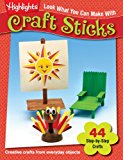
Look what you can make with craft sticks
This book offers dozens of easy-to-make items that start with craft sticks. Crafts include toys, games, gifts, and decorations, with full-color photographs, materials lists, and helpful tips for getting started.
|
![]()








 Attach two half sticks, flat side down, in the middle of the long side of the base, as shown below. These are the uprights.
Attach two half sticks, flat side down, in the middle of the long side of the base, as shown below. These are the uprights. 
 Attach a half stick across the uprights, on the opposite side from the braces. This is the crosspiece.
Attach a half stick across the uprights, on the opposite side from the braces. This is the crosspiece. 


 • Take your remaining half-stick and cut it in half again. This is your rope twister. Insert the flat end between the ropes. Twist backwards (away from the uprights) the desired number of times.
• Take your remaining half-stick and cut it in half again. This is your rope twister. Insert the flat end between the ropes. Twist backwards (away from the uprights) the desired number of times. 




